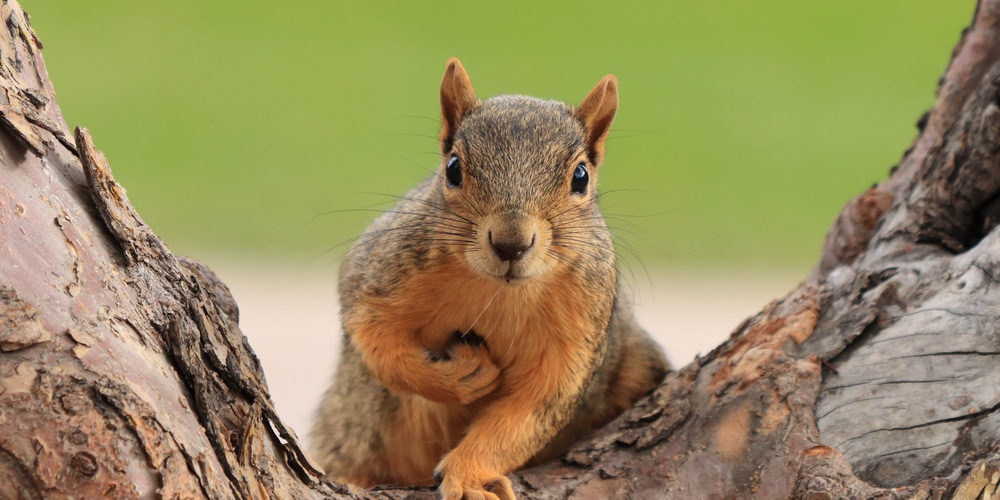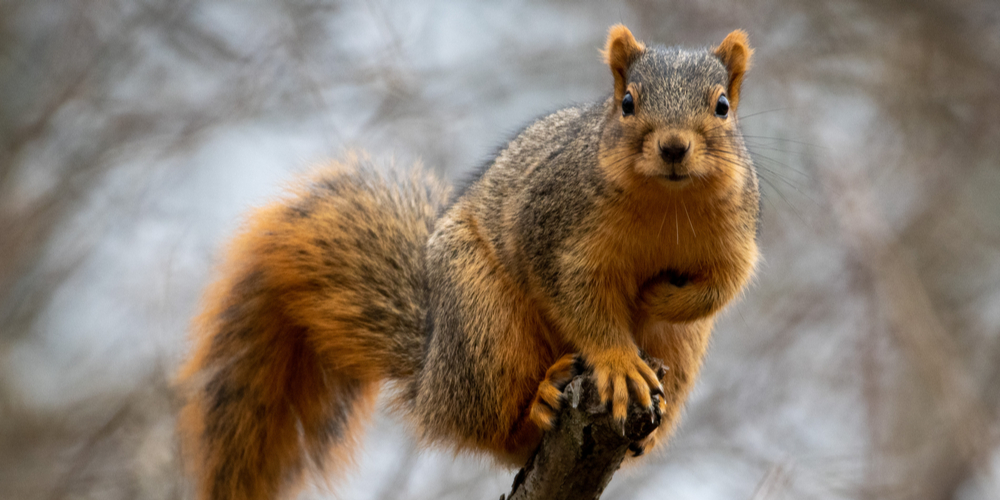Relatively larger than other squirrel species, the fox squirrel is an interesting small mammal that can be found in South Georgia and north Florida. Fox squirrels in Florida tend to weigh between one and three pounds with white nose and ears and a black head.
But is this species native to the area? What are its behaviors, mating cycles, and threats? Let’s take a closer look at the fox squirrel.
Fox squirrels in Florida
The fox squirrel (Sciurus niger) was named after a renowned ecologist called H. B. Sherman, an esteemed ecologist who specialized in small mammals. Sherman made significant contributions to his field by researching native Florida mammals like the fox squirrel.
Today, you can find these animals in places with sandhill habitats and longleaf pines. Much of their natural habitat has been lost due to deforestation and development, which is why they are protected throughout Florida. Florida law prohibits the capture and hunting of fox squirrels.
In terms of nativity, fox squirrels are native to Florida and continue to live there. There are several subspecies of the fox squirrel in the state, including:
- Sherman’s fox squirrel,
- Big Cypress fox squirrel (Sciurus niger avicennia), found southwest of Lake Okeechobee
- Southern fox squirrel
Appearance
As mentioned, the fox squirrel weighs between one and three pounds and is usually black (head) with a white nose and ears. This species can manifest color variations from gray to a buff hue but the under parts tend to be lighter.
Fox squirrels are well known for their long bushy tails and muscular hind legs that enable them to leap high and move from place to place very fast. While gray squirrels typically have 22 teeth, fox squirrels only have 20.
Behavior and Diet
Compared to gray squirrels, fox squirrels are less abundant and more difficult to spot. However, you can sometimes see them foraging for food in openings or pastures next to forested areas.
They spend less of their time in trees and more on the ground. In fact, when confronted by a predator or enemy, fox squirrels are more likely to run than climb.
Fox squirrels mate in midsummer and late winter. Their young are born during early spring or late winter as well as in the summer.
On average, a female fox squirrel will start breeding at around one year of age and produce one litter every year. The gestation period for this species is about 44 days, with the litter size ranging from one offspring to five but generally two or three.
Young fox squirrels are weaned at two or three months and their diet – as that of the adults – expands to include plant materials. Fox squirrels eat buds, fruit, fundi, seeds, and nuts and seem to have a preference for pine seed. Occasionally, they will consume animal material like bird eggs and insects.
Habitat
In Florida, you can find the fox squirrel in a wide range of places, including mangrove swamps, cypress and pine stands, and in open woods.
The state protects this species from hunting so they are free to roam around. However, only two of the four subspecies of fox squirrel in Florida are listed as protected species. These are:
- Sherman’s Fox Squirrel: This subspecies is of special concern to the state. You can find it in Northeastern and central Florida, more specifically in open pine woods.
- The Big Cypress Fox Squirrel: This subspecies lives in the Everglades region, Lee county, t southern Dade county. It is considered a threatened species.
The other two fox squirrel subspecies are considered less vulnerable. They are also more widespread and can be found in the western panhandle.
Threats
The main threat faced by the fox squirrel is habitat destruction, which is caused by human development, farming, and deforestation. In Florida, this problem is significant and estimates show that only 10 to 20 percent of the original habitat for this species is still intact.
The rest of it has been used for residential and commercial development, agriculture, pasture, or logging.
Lack of fire also affects the natural habitat for fox squirrels. Improperly burned longleaf pine areas prevent pine seeds from reproducing properly in the bare ground. Additionally, the slow gait of the southern fox squirrel puts it at high risk for being hit by cars.
Conservation and Management
Previously, the Sherman’s fox squirrel was designated as a species of special concern in the state of Florida.
However, thanks to their resilient response to habitat modification, this status has been dropped. The Endangered and Threatened Species Rule in Florida still protects the southern fox squirrel as a State Species of Special Concern by Florida’s Endangered although this conservation status is under assessment.
Fox squirrels in Florida: Conclusion
So, are fox squirrels native to Florida? Yes, they are. Fox squirrels in Florida live in areas with wiregrass or longleaf pine, especially in sandhills.
They can also be found in Georgia although most of their natural habitat has been lost to development, farming, and deforestation. Typically, you will find a fox squirrel nesting in an oak tree using Spanish moss and leaves.
Related Article: Do Foxes Eat Squirrels?

